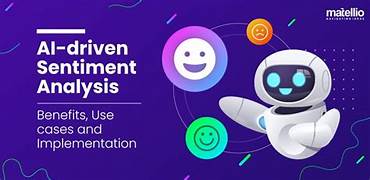AI Applications in Sentiment Analysis for Customer Feedback
In the era of digital transformation, businesses are increasingly focused on understanding and enhancing customer experiences. A key component of this effort is analyzing customer feedback to gauge satisfaction, identify areas for improvement, and align strategies with customer expectations. However, the sheer volume of feedback generated through surveys, social media, reviews, and support interactions makes manual analysis impractical. This is where Artificial Intelligence (AI) and sentiment analysis come into play.
Sentiment analysis, powered by AI, enables businesses to process large volumes of text data, extract meaningful insights, and classify sentiments—positive, negative, or neutral. This article explores the role of AI in sentiment analysis for customer feedback, the underlying technologies, applications across industries, benefits, challenges, and future prospects.
Understanding Sentiment Analysis
Sentiment analysis, also known as opinion mining, is the process of using natural language processing (NLP), machine learning (ML), and AI to determine the emotional tone behind a piece of text. The goal is to identify whether the sentiment expressed in the text is positive, negative, or neutral. By analyzing customer feedback, businesses can better understand their customers’ opinions, emotions, and pain points.
Key Components of Sentiment Analysis:
- Text Preprocessing: Removing noise from data, such as stop words, special characters, or irrelevant text, to prepare it for analysis.
- Feature Extraction: Identifying key features, such as keywords, phrases, or linguistic patterns, that indicate sentiment.
- Classification Models: Using ML algorithms or AI models to classify text into predefined sentiment categories.
The Role of AI in Sentiment Analysis
AI enhances sentiment analysis by improving accuracy, scalability, and adaptability. Here’s how AI is leveraged in sentiment analysis:
1. Natural Language Processing (NLP)
NLP is a subset of AI that enables machines to understand, interpret, and respond to human language. It is the backbone of sentiment analysis, helping algorithms process text data effectively.
- Syntax Analysis: Parsing sentences to understand grammar and structure.
- Semantic Analysis: Understanding context and meaning behind words and phrases.
- Sentiment Lexicons: Utilizing dictionaries of words tagged with sentiment values to assist in classifying feedback.
2. Machine Learning (ML)
ML algorithms are trained on labeled datasets to recognize patterns associated with different sentiments. Over time, these models become more accurate in detecting nuances and complexities in feedback.
- Supervised Learning: Training models on labeled datasets to predict sentiment.
- Unsupervised Learning: Identifying sentiment patterns without prior labeling.
3. Deep Learning
Deep learning models, such as neural networks, are particularly effective in understanding complex linguistic patterns and contextual nuances. Techniques like recurrent neural networks (RNNs) and transformers (e.g., BERT) have revolutionized sentiment analysis by enabling high precision.
4. Aspect-Based Sentiment Analysis (ABSA)
ABSA goes beyond overall sentiment classification by analyzing sentiments related to specific aspects of a product or service. For example, a review might praise a hotel’s location but criticize its customer service. AI-powered ABSA can dissect such feedback for targeted insights.
Applications of AI in Sentiment Analysis for Customer Feedback
AI-driven sentiment analysis has wide-ranging applications across industries. Here’s how businesses are leveraging this technology:
1. Customer Service Optimization
Sentiment analysis helps identify dissatisfied customers and prioritize their concerns for faster resolution. AI-powered tools analyze customer support interactions, flagging negative sentiments in real-time to ensure timely intervention.
2. Social Media Monitoring
Social media platforms are a goldmine of customer opinions. AI tools monitor brand mentions, hashtags, and comments to gauge public sentiment and address issues before they escalate. For instance, a spike in negative mentions after a product launch could prompt immediate corrective actions.
3. Product Improvement
By analyzing feedback from reviews and surveys, businesses can identify recurring issues and areas for improvement. For example, a tech company might use sentiment analysis to understand common complaints about battery life in a new smartphone model.
4. Marketing Strategy Enhancement
Sentiment analysis helps evaluate the effectiveness of marketing campaigns. Positive sentiment around a campaign indicates its success, while negative sentiment highlights the need for adjustments.
5. Competitor Analysis
Analyzing sentiment related to competitors’ products or services provides valuable insights into market positioning. Businesses can identify gaps and opportunities based on customer opinions about competitors.
6. Employee Feedback
Beyond customers, sentiment analysis is also applied to employee feedback to measure workplace satisfaction and identify areas for improving company culture.
Benefits of AI-Driven Sentiment Analysis
- Scalability
AI-powered tools can process vast amounts of data in real-time, far beyond the capacity of human analysts. - Accuracy and Consistency
AI models eliminate human biases and inconsistencies, providing objective and reliable sentiment classifications. - Actionable Insights
Sentiment analysis transforms unstructured feedback into actionable insights, enabling data-driven decision-making. - Proactive Problem-Solving
Real-time sentiment analysis allows businesses to address customer concerns proactively, enhancing satisfaction and loyalty. - Cost Efficiency
Automating sentiment analysis reduces the need for manual labor, lowering operational costs.
Challenges in AI-Driven Sentiment Analysis
Despite its advantages, AI-driven sentiment analysis faces several challenges:
1. Context Understanding
Understanding context is critical for accurate sentiment classification. For example, the phrase “this product is the bomb” might be classified as negative without recognizing its slang meaning as positive.
2. Sarcasm and Irony
AI struggles to detect sarcasm or irony, which can skew sentiment results. For instance, “Great, another update that breaks everything!” may be misinterpreted as positive.
3. Language and Cultural Nuances
Sentiment analysis must account for variations in language use across regions and cultures. A word that conveys positivity in one context might have a different connotation elsewhere.
4. Aspect-Based Challenges
Extracting sentiment for specific aspects within a single piece of feedback can be complex. For instance, a review might include both positive and negative sentiments about different product features.
5. Data Quality
The quality of input data significantly impacts the accuracy of sentiment analysis. Poorly written feedback, spelling errors, or incomplete sentences can pose challenges.
Tools and Technologies for Sentiment Analysis
Numerous AI-powered tools are available for sentiment analysis, catering to businesses of all sizes. Popular tools include:
- Google Cloud Natural Language API: Provides sentiment analysis capabilities as part of its broader NLP offerings.
- IBM Watson Tone Analyzer: Analyzes customer emotions and tones in text data.
- Microsoft Azure Text Analytics: Offers sentiment analysis and key phrase extraction.
- MonkeyLearn: A no-code AI platform for sentiment analysis.
- Hootsuite Insights: Focused on social media sentiment analysis.
Future Trends in Sentiment Analysis
- Improved Contextual Understanding
Advancements in NLP, such as transformers and large language models, will enhance AI’s ability to understand context, sarcasm, and complex linguistic patterns. - Real-Time Multilingual Analysis
Future sentiment analysis tools will seamlessly process multilingual feedback in real-time, catering to global audiences. - Integration with Voice Feedback
AI will expand beyond text to analyze sentiment in voice interactions, capturing emotions through tone and inflection. - Personalized Customer Interactions
Sentiment insights will enable hyper-personalized customer interactions, tailoring responses and recommendations to individual preferences. - Greater Adoption of ABSA
Aspect-based sentiment analysis will become more widespread, providing granular insights into specific product or service attributes.
Conclusion
AI applications in sentiment analysis have revolutionized how businesses understand and respond to customer feedback. By transforming unstructured text data into actionable insights, AI empowers organizations to enhance customer experiences, optimize products, and stay competitive in a fast-paced digital landscape. While challenges remain, ongoing advancements in AI, NLP, and machine learning promise a future where sentiment analysis becomes more accurate, context-aware, and integral to customer-centric strategies.
As AI continues to evolve, its role in sentiment analysis will expand, enabling businesses to unlock deeper insights and build stronger connections with their customers. Whether through real-time social media monitoring or proactive customer support, sentiment analysis will remain at the heart of modern business intelligence.


